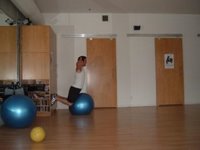
Workout Routine
Nice solid leg workout today.
But before I did mine, while working with a client, I watched another trainer go through his leg workout. It was pretty solid as well, until he decided to do a plyometric exercise at the end of his workout.
Plyometrics should be performed at the start of the workout, when your muscles have energy and are not fatigued. Doing plyometrics at the end of the workout will not help increase power as much as doing them at the start.
It's these seemingly small mistakes that I see in almost everyone's training programs...mistakes that can easily be fixed if they truly understand the basic foundations of physiology.
The problem is, most trainers only know exercises, not the foundations of exercise programming.
If I were going to refer people to a resource to help understand the foundations of exercise programming, it wouldnt be any of the certificaitons out on the market. Instead, it would be
Alwyn Cosgrove's Program Design Manual - Click HERE to get it.
And here's a great bit of info that I received in Brian Grasso's newsletter today (go here for his newsletter: www.developingathletics.com)
...(Plyometrics) Shouldn't Be 'Hard'
Of important note with respect to execution and prescription is that if the transfer from braking to acceleration takes longer than 0.2 seconds, than the activity would not fall under the parameters of shock or plyometric training.
This is a crucial point considering that many trainers and coaches use ‘plyometric’ training to such an extreme level (i.e. increased number of reps and timed sets or decreased amount of rest between sets) that young athletes are simply not able to produce quick explosive and eccentric actions.
Having said that, speed-strength is not being produced or improved. It is exceedingly decisive to remember that when training young athletes, the goal should not be to create as physically difficult a training session as possible.
In fact, as with shock or plyometric training, the more physically challenging the exercise or training session is, the less you are actually improving the speed-strength capacity of the athlete – which is the reason you were offering plyometrics to begin with!"
Also check out Brian's Youth Training site, www.iyca.org
Now back to my workout routine:
1A) Medium Stance Squat (3x6) ===> this was okay, gotta bring that squat up!
1B) Plank (2x120seconds)
2A) Good Morning (3x10) ===> I'm weak here!
2B) Ball Crunch (3x15)
3A) Glute-Ham Raise on Ball (3x10 with weight) ===>Pictured
3B) Tubing Chop (3x10)
CB
workout routine















No comments:
Post a Comment